Prompted by a request from Mary Willson for more information about a picture I took of Monilinia, I started to gather what I knew. It didn’t take long before I realized I would probably be better off just writing this post.
Some Context and References
Monilinia species can have a fairly involved life-cycle, including mummified berries in the summer and apothecia (fruiting cups) in the spring. For more details, see this report on M. vaccinii-corymbosi, an economically significant challenge for commercial blueberry growers. We probably have different species of Monilinia in Southeast Alaska, but it seems likely the life-cycle is basically the same.
The fungal host database is a compilation of literature records of fungus/host relationships. In this case, I searched for fungus genus Monilinia with host family Ericaceae (there are Monilinia species which infect plants in other families, but what I’ve observed here makes me primarily interested in those infecting blueberries and other Ericaceous shrubs).
Based on host records from the host database, it looks like the following species would be a starting point for species that could occur in Southeast Alaska:
- M. cassiopes (host: Cassiope tetragona)
- M. ledi (hosts: Rhododendron tomentosum, Vaccinium uliginosum)
- M. megalospora (host: V. uliginosum)
- M. oxycocci (host: V. oxycoccos)
- M. urnula (host: V. vitis-idaea)
- M. vaccinii-corymbosi (several hosts reported among larger shrub blueberries, though none listed which occur in Southeast Alaska)
iNaturalist observations of Monilinia in Alaska
My Observations


I’ve observed two (possibly three) stages of the cycle.
I can’t remember when I first was aware of mummy berries, but I suspect it goes back to my childhood. (My dad probably picked hundreds of gallons of blueberries here from the mid-70s through mid-90s. When I asked, he did remember finding mummy berries. He said some years there were lots of them, other years not many.)

I first found the apothecia stage in mid-June 2009. It was in a muskeg well up Indian River valley. I noticed a small cup on the end of a long slender stalk. My notes with the photo suggest that I looked for a berry at the time but didn’t find one. I don’t remember how I got a name for them. Kitty LaBounty was with me, and may have told me the name at the time.


I next found one in a muskeg on 1 June 2012. This time I pulled apart the Sphagnum to find the berry from which the fruiting cup had grown. Based on the berry’s shape and long stem, I believe the host plant was bog cranberry (V. oxycoccos).
In 2017 I began to an effort to seek them out. In May I documented them in a low elevation muskeg. (I think the same as where I had seen it in 2012.)

Since I had previously seen mummy berries on Harbor Mountain, I made a point of going up there when the gate had opened. I found several which had parasitized V. cespitosum.

I found at least one that appeared to have parasitized copperbush (Elliottia pyroliflora) – though that species was not in the list of hosts of Monilinia spp in the fungal host database.

I found another that wasn’t associated with blueberry (the host fruit did not appear to be a blueberry, and there were no Vaccinium nearby). It may have grown from Harimanella stellariana or Cassiope mertensiana, which were both growing where I found the fungus.


In recent years I have had no trouble finding Monilinia in the spring. For low elevation muskegs, I go looking for them in May. Though I have found one as early as late March (this is the only one I’ve yet found growing on one of the taller blueberries).


I haven’t made as much effort to find them at montane/subalpine elevations. However, based on what I have seen I would look for them there when the snow is still melting. When I’ve found them it’s not been long after snow has departed from a patch of ground (and they don’t always wait for the snow to disappear).
Questions
- Vaccinium cespitosum has apparently not been previously reported as a host (based on fungal host database records). Which species of Monilinia is infecting it?
- Can Monilinia infect copperbush (Elliottia pyroliflora)? If so, is it a new species of Monilinia?
- Cassiope tetragona is listed as a host for M. cassiopes. Can this species infect other Cassiope, in particular C. mertensiana? Can it infect Harrimanella stelleriana?
- M. ledi has been reported to infect Rhododendron tomentosum (which would only occur at the northern margins of Southeast Alaska). Could it also infect the related labrador tea (R. groenlandicum)? In my memory, I found some I thought may have been associated with R. groenlandicum, but if that’s true, I didn’t document them well enough to be sure. (I think it was probably this observation, though.)
- Are both V. ovalifolium and V. alaskaense susceptible to infection? Neither are reported as hosts in the fungal host database, but I’ve found mummy berries on V. ovalifolium. I don’t remember if I’ve seen them on V. alaskaense. I’ve not documented them, if I have.
- I’ve previously noted a leaf blight. It’s reasonably common, but does not seem to significantly impact the health of the blueberry bushes beyond the occasional shoot dying back. The article linked near the top includes under symptoms: “severe wilting of vegetative and floral shoots, followed by a brown discoloration or blight, may occur in some years but not all“. Is the blight we’re seeing here related to that stage of a Monilinia infection?

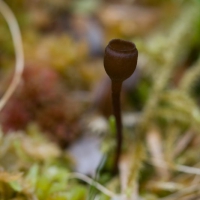
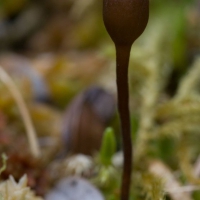
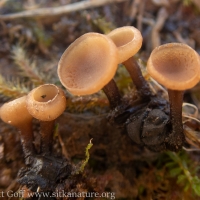
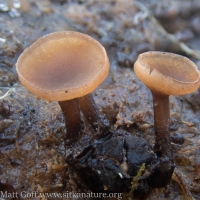
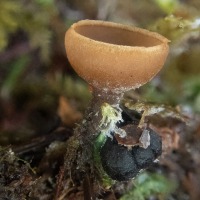
interesting!